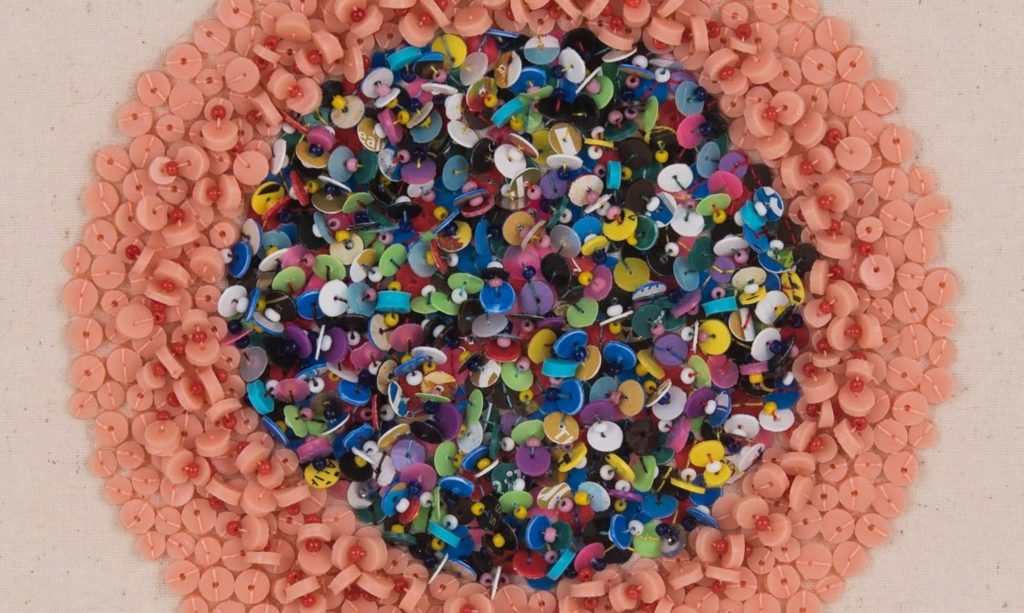
Cloth hugs and holds the body, it becomes a part of each individual’s identity, it traps smells, stains, and moulds to the body almost like a second skin.
Cloth cleans, dries, and protects. When weeping, cloth wipes away tears. When bleeding or oozing, cloth bandages. Then thread stitches skin back together. At night, the body snuggles into layer upon layer of cloth for warmth and comfort. The minute a baby is born it is wrapped in cloth. Cloth plays a crucial role in the rituals of death; from cleaning and dressing in final robes, to embalming.
Clothing can hide, disguise, mask, adorn, and decorate the body. In the 18thcentury, “Georgian women went to great lengths to cover [pox] marks with ‘beauty spots’ made of fine black velvet, or mouse skin.”[1]From the most lowly of fabrics like gauzes and handkerchiefs that wipe away bodily fluids, to the most elaborate. From the humblest of uses to the most glorified, cloth can be transformative. We rely on cloth from birth to death. And yet, for all its undeniable value, cloth is oft-discarded.
In Sleeper Cells, textile artist Cheryl Hutchens works with found and recycled cloth and single-use plastics, giving these discarded materials new life. Old sheets, embroidered hankies, children’s clothing “one is mine and one is my sons”[2]– they all contain human history. Each piece, roughly the same size of an adults outstretched hand, echoes the fabrics handmade origins. They sleep no longer, awoken by light, colour, and stitch. Hutchens fastens handmade sequins to these stained, worn cloth, and recreates textures and patterns that mimic pox ridden skin and Georgian embroidery.
Each labour-intensive sequin is cut using primitive tools from a range of everyday items that would otherwise go to landfill – old dolls, bottle lids, sushi boxes, food packaging, and netting. Hutchens’ studio reveals other treasures: a generous plastic collection, traditional embroidery looms, hole punches, colour wheels, graphic research images of syphilis, a human brain, a Laysan albatross chick carcass with plastic filling its stomach, and 18thcentury Georgian beadwork.
Hutchens uses colours that intentionally jar, forming a network of chaotic and unruly colour, which blasts the eye with a busy-ness of synthetic disorder – sewn with the precision of a practised hand. The layered sequins and beads cluster, grow, spread, and pimple across the smooth plane of the cloth, each kept in-check with flesh-coloured stitch work. Their gleam and nipple-like appearance allure and beckon fingertips to brush over their deadly, contagious reality.
Other patterns are recognisably Georgian; floral and delicate. From a time of extreme wealth, elaborate parties and excessive living, where pleasure and indulgence were paramount, where one ordered a prostitute as if picking her from a wine menu. Fittingly, this was also the height of the syphilis epidemic, before the penicillin cure. A time when many bodies, innocent and guilty alike, fell victim to infection, and inevitable death.
Many binaries are juxtaposed here: beauty with grotesque, chaos with order, science with nature, resilience with fragility, birth with death. This work examines the “decadence and arrogance that permeates our culture”[3],revealing truths about the world we live in and the impact of our actions; from the continued use of plastic and the risk of plastic infiltrating the human body, to the spread of disease and infection.
Sleeper Cells presents works that highlights fractured moments in time. When the body endured difficulty. Here, the ugly and complex inner workings of the body are made beautiful with the simplicity of cloth, thread and repurposed plastics.
‘Cloth Body Nature’ was a commissioned catalogue essay for Cheryl Hutchens solo textile exhibition Sleeper Cells at Floating Goose 4 October – 27 October 2019.
[1]Fitzharris, L., 2014, The Syphilitic Whores of Georgian London, published by Dr Lindsey Fitzharris, date viewed 28/9/2019, <https://www.drlindseyfitzharris.com/2014/03/03/the-syphilitic-whores-of-georgian-london/>
[2]Quote from artist
[3]Ibid